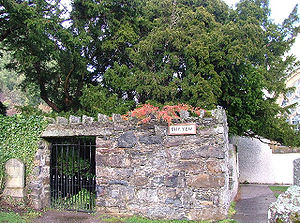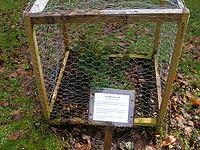
Fortingall Yew
Encyclopedia

Taxus baccata
Taxus baccata is a conifer native to western, central and southern Europe, northwest Africa, northern Iran and southwest Asia. It is the tree originally known as yew, though with other related trees becoming known, it may be now known as the English yew, or European yew.-Description:It is a small-...
) in the churchyard of the village of Fortingall
Fortingall
Fortingall is a small village in highland Perthshire, Scotland, in the glen of the River Lyon. Place-name Gaelic Fartairchill, 'church at the foot' . Its nearest sizable neighbours are Aberfeldy and Kenmore.According to legend it was the birthplace of Pontius Pilate...
in Perthshire
Perthshire
Perthshire, officially the County of Perth , is a registration county in central Scotland. It extends from Strathmore in the east, to the Pass of Drumochter in the north, Rannoch Moor and Ben Lui in the west, and Aberfoyle in the south...
, Scotland
Scotland
Scotland is a country that is part of the United Kingdom. Occupying the northern third of the island of Great Britain, it shares a border with England to the south and is bounded by the North Sea to the east, the Atlantic Ocean to the north and west, and the North Channel and Irish Sea to the...
. Various estimates have put its age at between 2,000 and 5,000 years; recent research into yew tree ages suggests that it is likely to be nearer the lower limit of 2,000 years. This still makes it the oldest known tree in Europe
Europe
Europe is, by convention, one of the world's seven continents. Comprising the westernmost peninsula of Eurasia, Europe is generally 'divided' from Asia to its east by the watershed divides of the Ural and Caucasus Mountains, the Ural River, the Caspian and Black Seas, and the waterways connecting...
, although the root system of the Norway spruce
Norway Spruce
Norway Spruce is a species of spruce native to Europe. It is also commonly referred to as the European Spruce.- Description :...
"Old Tjikko
Old Tjikko
Old Tjikko is a 9,550 year old Norway Spruce tree, located on Fulufjället Mountain of Dalarna province in Sweden. Old Tjikko is the world's oldest living individual clonal tree, however, there are many examples of much older clonal colonies , such as "Pando", estimated to be over 80,000 years...
" in Sweden
Sweden
Sweden , officially the Kingdom of Sweden , is a Nordic country on the Scandinavian Peninsula in Northern Europe. Sweden borders with Norway and Finland and is connected to Denmark by a bridge-tunnel across the Öresund....
is older.
The yew tree
The yew's once massive trunk (16 metres, or 52 feet in girth when it was first taken notice of in writing, in 1769) with a former head of unknown original height, is split into several separate stems, giving the impression of several smaller trees, with loss of the heartwood rings that would establish its true age. This is a result of the natural decay of the ancient heartwood, which reduced the centre of the trunk down to ground level by 1770. Other than this the tree is still in good health and may last for many more centuries. By 1833 it was noted that "large arms had been removed and even masses of the trunk, carried off, to make drinking-cupsMazer
Mazer may refer to:*Mazer , a type of Germanic drinking vessel crafted from the 13th to the 16th centuries*Mazer, slang for a person who brews mead*Mazer Rackham, a fictional character from Orson Scott Card's Ender's Game series...
and other curiosities" It is protected by a low wall erected in 1785to preserve it but it can still be easily viewed.
Clippings from the tree are to be taken to the Royal Botanic Gardens
Royal Botanic Garden Edinburgh
The Royal Botanic Garden Edinburgh is a scientific centre for the study of plants, their diversity and conservation, as well as a popular tourist attraction. Originally founded in 1670 as a physic garden to grow medicinal plants, today it occupies four sites across Scotland — Edinburgh,...
in Edinburgh to form part of a mile long hedge. The purpose of this "Yew Conservation Hedge Project" is to maintain the DNA
DNA
Deoxyribonucleic acid is a nucleic acid that contains the genetic instructions used in the development and functioning of all known living organisms . The DNA segments that carry this genetic information are called genes, but other DNA sequences have structural purposes, or are involved in...
of Taxus baccata
Taxus baccata
Taxus baccata is a conifer native to western, central and southern Europe, northwest Africa, northern Iran and southwest Asia. It is the tree originally known as yew, though with other related trees becoming known, it may be now known as the English yew, or European yew.-Description:It is a small-...
from ancient specimens in the UK as, worldwide, the trees are threatened by felling and disease.
History
The area immediately surrounding Fortingall has a variety of prehistoric archaeological sites including Càrn na MarbhCarn na Marbh
Càrn na Marbh is a re-used Bronze Age tumulus, located in Fortingall in Perthshire, Scotland. The mound was used in the 14th century for burying victims of the plague away from the church graveyard...
, a Bronze Age
Bronze Age
The Bronze Age is a period characterized by the use of copper and its alloy bronze as the chief hard materials in the manufacture of some implements and weapons. Chronologically, it stands between the Stone Age and Iron Age...
tumulus
Tumulus
A tumulus is a mound of earth and stones raised over a grave or graves. Tumuli are also known as barrows, burial mounds, Hügelgrab or kurgans, and can be found throughout much of the world. A tumulus composed largely or entirely of stones is usually referred to as a cairn...
. Place-name and archaeological evidence hint at an Iron Age
Iron Age
The Iron Age is the archaeological period generally occurring after the Bronze Age, marked by the prevalent use of iron. The early period of the age is characterized by the widespread use of iron or steel. The adoption of such material coincided with other changes in society, including differing...
cult centre at Fortingall, which may have had this tree as its focus. The site was Christianised
Christianised sites
One aspect of Christianisation was the Christianisation of sites that had been pagan. In the 1st centuries of Christianity churches were either house churches in whatever houses were offered for use by their owners, or were shrines on the burial-sites of martyrs or saints, which following the usual...
during the Dark Ages, with the yew already full grown, perhaps because it was already a sacred place. A recollection of 1806 noted that "the boys of the village" had damaged the yew "kindling their fire of Bealltuinn
Beltane
Beltane or Beltaine is the anglicised spelling of Old Irish Beltaine or Beltine , the Gaelic name for either the month of May or the festival that takes place on the first day of May.Bealtaine was historically a Gaelic festival celebrated in Ireland, Scotland and the Isle of Man.Bealtaine...
at its root.""
Legend
According to local legend, Pontius PilatePontius Pilate
Pontius Pilatus , known in the English-speaking world as Pontius Pilate , was the fifth Prefect of the Roman province of Judaea, from AD 26–36. He is best known as the judge at Jesus' trial and the man who authorized the crucifixion of Jesus...
was born in its shade and played there as a child. This is considered unlikely as North Britain was not part of the Roman Empire at that time.
See also

- List of trees
- List of oldest trees
- Llangernyw YewLlangernyw YewThe Llangernyw Yew is an ancient yew in the churchyard of the village of Llangernyw in Conwy County Borough, North Wales. The tree is fragmented and its core part has been lost, leaving several enormous offshoots. The girth of the tree at the ground level is 10.75 m.-History:This male yew tree...
- reputedly the oldest yew in the British Isles

